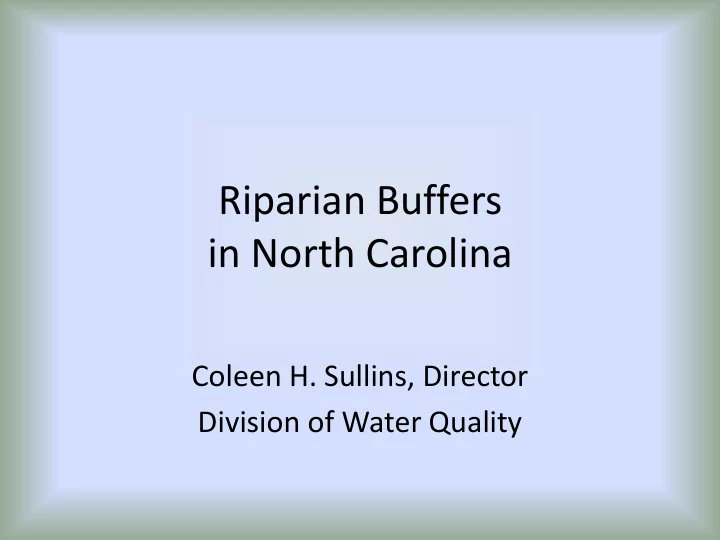

Riparian Buffers in North Carolina Coleen H. Sullins, Director Division of Water Quality
What is a Riparian Buffer? • A riparian buffer is a strip of forested or vegetated land bordering a body of water 2 Photo courtesy of USDA
3
4
5
6
Photo courtesy of NCDENR 7
8
N.C. General Assembly took action June 19, 1996 • SL 1995-572 – Directed the Environmental Management Commission (EMC) to develop a plan to reduce the average annual load of nitrogen to the Neuse River Estuary by 30% 9 Photos courtesy of NCDENR and UNC-Chapel Hill
Neuse Management Strategy • The EMC adopted the Neuse River Basin - Nutrient Sensitive Waters Management Strategy for: – protection and maintenance of riparian areas – wastewater discharges – urban stormwater management – agricultural nitrogen reduction – fertilizer management – nitrogen offset fees 10
How do Riparian Buffers Work? Vegetation slows and filters pollutants in surface runoff Roots of vegetation take up subsurface Nitrogen and enhance denitrification. 11
How do Riparian Buffers Work? • Studies show that the first 50 feet adjacent to a water body provide the highest proportion of water quality benefits 12 Photos courtesy of NC DWQ and NC State Parks
Buffer Benefits • Remove nutrients • Filter stormwater runoff 13 Photos courtesy of DENR, WakeUp Wale County
Buffer Benefits Flood control Prevent erosion Provide fish & wildlife habitat 14 Photos courtesy of ASU, NCSWC and NCDENR
Buffer Benefits • A study done in Craven County found that waterfront property commands a higher premium compared to an otherwise equivalent property • The study also found that the mandatory riparian buffer rules did not lower waterfront property values 15 Photos courtesy of NC State Parks
Neuse Riparian Buffer Rules • Initial rules adopted in July 22, 1997 – Main purpose: protect existing stream buffers • Revised rules – SL 1998-221: Stakeholder Advisory Committee – June 1999: Revised rules adopted by EMC 16
North Carolina Riparian Buffer Rules Randleman Watauga New Roanoke Yadkin- Tennessee Catawba Pee Dee French Broad Neuse Broad Cape Fear Savannah Hiwassee Goose Creek White Oak Neuse River Basin Catawba River Basin (Jun. 30, 2001) (Jul. 22, 1997/ Aug. 1, 2000) Randleman Lake Watershed Goose Creek Watershed (Feb. 1, 2009) (Apr. 1, 1999/Jun. 1, 2010) Tar-Pamlico River Basin (Aug. 1, 2000) Jordan Lake Watershed (Aug. 1, 2009) 17
The Benefits are Crystal Clear • Riparian buffers provide many benefits – Remove nutrients – Filter stormwater runoff – Provide flood control – Prevent erosion / protect investment – Provide fish and wildlife habitat Jordan Lake - August 2005 – Protect tourism industry • Riparian buffer protection rules are part of comprehensive strategies to address water quality issues 18 Phelps Lake - July 2005
19
Recommend
More recommend